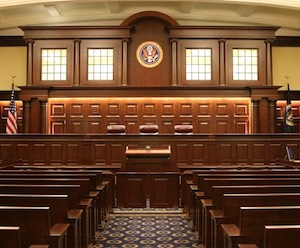In determining whether newly alleged claims, based on separate patents, relate back to the date of the original complaint, the Federal Circuit presented a nonexhaustive list of five factors to consider.
 Recently, the Federal Circuit reversed, vacated and remanded a decision of the U.S. District Court for the District of Colorado that granted Mushkin, Inc.’s (“Mushkin’s”) motion to dismiss Anza Tech.’s (“Anza”) complaint seeking damages for alleged patent infringement occurring between March 2011 and April 2012 because the claim for damages was time-barred by the six-year statute of limitations in the Patent Act, 35 U.S.C. § 286. See Anza Tech., Inc. v. Mushkin, Inc., No. 2019-1045, 2019 U.S. App. LEXIS 24432 (Fed. Cir. Aug. 16, 2019) (Before Prost, Chief Judge, Newman and Bryson, Circuit Judges) (Opinion for the Court, Bryson, Circuit Judge).
Recently, the Federal Circuit reversed, vacated and remanded a decision of the U.S. District Court for the District of Colorado that granted Mushkin, Inc.’s (“Mushkin’s”) motion to dismiss Anza Tech.’s (“Anza”) complaint seeking damages for alleged patent infringement occurring between March 2011 and April 2012 because the claim for damages was time-barred by the six-year statute of limitations in the Patent Act, 35 U.S.C. § 286. See Anza Tech., Inc. v. Mushkin, Inc., No. 2019-1045, 2019 U.S. App. LEXIS 24432 (Fed. Cir. Aug. 16, 2019) (Before Prost, Chief Judge, Newman and Bryson, Circuit Judges) (Opinion for the Court, Bryson, Circuit Judge).
The controversy began in March 2017 when Anza filed suit against Mushkin in the U.S. District Court for the Eastern District of California, alleging that Mushkin infringed claims 1, 14, and 16 of Anza’s U.S. Patent No. 7,124,927 (“the ’927 patent”). On September 6, 2017, Anza filed its first amended complaint, which joined Avant Technology, Inc., as a co-defendant. Thereafter, the California district court granted Mushkin’s motion to sever Anza’s claims against Mushkin and transfer the case to the District of Colorado. Next, Anza, while engaging in mediation with Mushkin, conceded that its claims were no longer viable, which led to Anza filing a second amended complaint in June 2018 with the court’s permission.
District Court Finds No Relation Back
In Anza’s second amended complaint, Anza removed the infringement allegations regarding the ’927 patent and alleged infringement of two new patents: U.S. Patent Nos. 6,354,479 (“the ’479 patent”) and 6,651,864 (“the ’864 patent”). Anza also omitted 10 of the 16 products that had been accused in the original complaint and added two new products that had not previously been accused. The district court granted Mushkin’s motion to dismiss because the claims in Anza’s second amended complaint did not relate back to the date of Anza’s original complaint. Further, because Anza acknowledged that Mushkin’s allegedly infringing activity took place more than six years before the filing date of the second amended complaint, all the asserted claims in the second amended complaint were time-barred.
Under Rule 15(c)(1)(B) of the Federal Rules of Civil Procedure, “[a]n amendment to a pleading relates back to the date of the original pleading when … the amendment asserts a claim or defense that arose out of the conduct, transaction, or occurrence set out—or attempted to be set out—in the original pleading.” The district court found that, “[a]lthough the claims involve the same parties, they do not relate to identical products and technology.” Comparing the ’864 and ’479 patents with the ’927 patent, the district court found that the asserted claims of the ’864 and ’479 patents “protect a method of using a wire bonding tool, while the ’927 claims involved a flip chip bonding and solder ball placement tool.” The district court acknowledged that the patent claims have the “same purpose—bonding integrated circuit chips to printed circuit boards while minimizing electrostatic discharge.” But because it found that “different processes and technologies are used to achieve this purpose,” the district court held that the patent claims were “not part and parcel of one another.”
Federal Circuit Identifies Five Factors
In its determination of whether newly alleged claims, based on separate patents, relate back to the date of the original complaint, the Federal Circuit considered: (1) the overlap of parties, (2) the overlap in the accused products, (3) the underlying science and technology, (4) time periods, and (5) any additional factors that might suggest a commonality or lack of commonality between the two sets of claims.
Of course, the overlap of the parties existed, with Anza and Mushkin both being original parties in the suit. As mentioned above, the overlap of the accused products included six products in the second amended complaint from the original complaint. Regarding the underlying science and technology, the Federal Circuit found that the three patents focused on solving the same problem by the same solution, using a bonding tool tip made of a dissipative material having a resistance low enough to prevent the discharge of a charge to a device being bonded and high enough to avoid current flow to that device. With respect to the time periods, the Court determined there was no lack of notice and no substantial prejudice to Mushkin from having to defend against independent claims over a shorter period than the period set forth in the original complaint (the original complaint included the six-year period before March 2017, while the second amended complaint alleged damages occurring between March 2011 and April 1, 2012).
Accordingly, the Federal Circuit reversed the dismissal of the claims regarding the six overlapping products, finding that those products related back to the date of the original complaint. Regarding the two newly added products, the Federal Circuit vacated the order of dismissal and remanded for the district court to determine whether the allegations regarding those products relate back to the filing date of the original complaint.

![[IPWatchdog Logo]](https://ipwatchdog.com/wp-content/themes/IPWatchdog%20-%202023/assets/images/temp/logo-small@2x.png)


![[Advertisement]](https://ipwatchdog.com/wp-content/uploads/2024/04/Artificial-Intelligence-2024-REPLAY-sidebar-700x500-corrected.jpg)
![[Advertisement]](https://ipwatchdog.com/wp-content/uploads/2024/04/Patent-Litigation-Masters-2024-sidebar-700x500-1.jpg)

![[Advertisement]](https://ipwatchdog.com/wp-content/uploads/2021/12/WEBINAR-336-x-280-px.png)
![[Advertisement]](https://ipwatchdog.com/wp-content/uploads/2021/12/2021-Patent-Practice-on-Demand-recorded-Feb-2021-336-x-280.jpg)
![[Advertisement]](https://ipwatchdog.com/wp-content/uploads/2021/12/Ad-4-The-Invent-Patent-System™.png)






Join the Discussion
No comments yet.